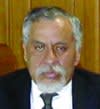The Bolivian banking system has proved resilient in the face of some severe shocks in the past few years. Luis Fernando Calvo Unzueta, the superintendent of banks and financial institutions in Bolivia, says: “I think in few parts of the world the banking system has been exposed to the sort of stresses that Bolivia has had to endure in the past few years but the system has withstood them.”
According to the Association of Private Banks (APB) in Bolivia, the level of financial assets has dropped by 40% to $2.6bn since 1998 and bank profitability has fallen by an equal amount over the period. Total deposits as a measure of gross domestic product are 32% today compared with 54% in 1998.
The main reason for the decline has been social unrest. There were major disturbances in August 2002 when no candidate won the presidential election outright and Congress chose Gonzalo Sánchez de Lozada again. The army intervened in February last year – leading to 32 deaths – when Mr Lozada’s government tried to reduce the amount by which VAT invoices could be deducted from income tax.
Popular revolt
The army was called in again in October last year – resulting in 80 deaths – to contain a popular revolt over Mr Lozada’s plans to export gas to the US through a new pipeline in Chile. Landlocked Bolivia has been in a territorial dispute with Chile over access to the Pacific since1879, when the two countries were at war. Left-wing groups, led by Evo Morales, were angry with the government for even considering the pipeline. President Lozada was forced to resign and was replaced by the vice-president, Carlos Mesa, who is expected to complete the term until 2007.
Each of these periods of unrest led to a run on bank deposits but Bolivia did not have to resort to banking restrictions, like neighbouring countries Argentina and Uruguay. Mr Mesa’s government introduced a transaction tax of 0.3% in January this year, which led to another run on banks of $190m.
Show of resilience
Juan Antonio Morales Anaya, who has been president of the Bolivian central bank for nine years, says: “The banking system has been severely shaken by these shocks but has proved resilient. It has been close to financial collapse on several occasions but has not fallen into the abyss. Citibank says only Chile has more stringent regulation in South America. Bolivia is not yet in accordance with Basel I but is convergent.”
Franco Urquidi, chief executive of Banco Unión, one of Bolivia’s biggest banks, says: “The biggest challenge has been to cope with the economic crises. Provisions have been quite big and just when we thought the worst was over, there was another run on banks in January.
“However, I think Bolivia has an effective banking supervisory system. All the banks are still up and running despite the profound economic and social crisis. Around 90% of non-performing assets are totally covered, which is not bad for a small, Third World country.” Banco Unión’s total assets are $233m and its total provisions are $55m (24% of total assets).
One of Bolivia’s biggest problems has been a highly dollarised banking system (Bolivians do not trust the boliviano after hyperinflation of 24,000% in 1982, although inflation is now 3.9%). About 92% of bank deposits are in dollars and 98% of loan portfolios but most people are paid in bolivianos and most goods are sold in the currency. The boliviano operates on a crawling peg, which devalues against the dollar at 4% a year, penalising anyone with dollar loans.
One of the most worrying aspects of the Bolivian banking system is the lack of independence of the superintendent of banks. “On December 21, 2002, the government intervened and reduced the amount of provisions that banks have to make against bad debts by 15%. That was a political decision. They wanted to neutralise the power of the superintendent,” says Mr Calvo Unzueta. He says he chose not to resign because he would probably have been replaced with a politician.

Luis Fernando Calvo Unzueta: ‘I do not agree with the banks pulling out of rural areas”
Low capital flight
The banking authorities admit some money left Bolivia during the social unrest but there are no hard figures available. Banks account for 85% of all financial assets and mutual funds account for the other 15%. About 18% of all loans are non-performing. The banking authorities now require banks to take into account future cash flow before granting a loan whereas in the past banks only considered collateral.
Carlos Melo, the Inter-American Development Bank’s permanent representative in Bolivia, says: “I think the fact that there has not been any big crash in the financial system demonstrates that the market is not that sophisticated. There has been no widespread capital flight like in Argentina because the system is not sophisticated enough here.
“Most Bolivian businessmen are merchants. They like to be able to look their bank managers in the face. They do not trust sending their money abroad.”
Bolivia is one of the poorest and most socially stratified countries in South America: 70% of the population lives below the poverty line (with an average purchasing power parity of $2500 in 2002, according to the CIA World Factbook). The APB confirms that 50% of total bank deposits are concentrated in just 1000 bank accounts. Poor people believe that they did not benefit from the privatisation of major utilities in the 1990s and this has fuelled much of the social unrest.
There are now 12 major banks in Bolivia, down from 14 in 1999 and 26 in 1990. The biggest is Banco Nacional, followed by Banco Mercantil, Grupo BISA, and Banco de Crédito de Bolivia. All of these are family-owned apart from Banco de Crédito, which is owned by Peruvian group Credicorp.

Juan Antonio Morales Anaya: “Bolivia is not yet in accordance with Basel I but is convergent”
Informal economy
“Foreign banks have found it tough to operate in Bolivia,” according to Emilio Unzueta Zegarra, president of the APB and chief executive of Banco Mercantil. “About 50% of the economy is informal and only local banks know how this sector works. Banco Santa Cruz was the biggest bank in Bolivia in 1999 before it was bought by Central Hispano (which in turn merged with Banco Santander) but it is now the fifth or sixth biggest.
“Citibank acquired the local bank Banco Hipotecario Nacional but has also had a bad experience. Bank Boston entered the Bolivian market but left,” he says.
Banco do Brasil has had more success by focusing on the banking needs of Brazilian companies doing business in Bolivia. José Eneas Bueno Junior, chief executive of Banco do Brasil in Bolivia, says: “La Paz is a model office for our bank in Latin America. In May 2002, we changed the focus of the bank away from Bolivian clients to working with Brazilian multinationals undertaking business in Bolivia.
“One of our major clients is Petrobras, which is heavily involved in Bolivia’s hydrocarbon industry. Brazil is the most important market for Bolivia with about 25% of formal international trade.”
Banco do Brasil made a profit of $870,000 in Bolivia last year and has lent $120m to build 410km of roads in the south of the country.

Emilio Unzueta Zegarra: only local banks know how the informal economy works
Rural banking
Private banks have a total of 418,000 bank accounts in the country (less than 7% of the adult population have bank accounts). One of the banking superintendent’s biggest concerns is banking in rural areas, where more than 40% of the population lives. A large number of the private banks have closed branches in rural areas.
“I do not agree with the banks pulling out of the rural areas,” says Mr Calvo Unzueta. “I know that it is not profitable for banks to compete with the institutions specialising in microfinancing in the rural areas, but people need banking services.”
However, during the past 10 years credit unions and co-operatives have developed in the rural areas – led by private companies Banco Sol and Prodem – which provide debit cards and savings accounts. They now have 1.2 million clients in total.
With a GDP of $7.9bn and a population of 8.4 million, Bolivia has suffered stagnant economic growth over the past six years after an economic boom and credit bubble in the late-1990s. Growth averaged a mere 1%-2% over the six years. The banks were unprofitable throughout the period, apart from last year when they returned to profitability. Between 1993 and 1997, Mr Lozada’s government allowed foreign companies to buy major stakes (known as “capitalisation”) in 159 public companies, helping to fuel the boom.

Carlos Melo: “There has been no widespread capital flight because the system is not sophisticated enough here”
Signs of growth
The economy has started to turn round this year because of the increase in commodity prices – especially soya – and the pick-up in neighbouring economies like Argentina. The Bolivian Central Bank predicts growth of 3.6% this year and 5.8% next year. The country has a current budget deficit of 8% of GDP and external debt of $5bn. The government is attempting to reduce the deficit through an austerity programme.
Bolivia could have a bright future but is still hindered by social unrest. It has 8% of the world’s biodiversity and huge tourism potential. About 55,000bn cubic feet of gas reserves have been discovered. However, much of the rural population is against exporting the gas abroad because it believes it did not benefit from past foreign investment. A crunch referendum will take place on the issue in July.
The banking industry has endured many challenges over the past few years but has managed to escape an Argentine-style meltdown and is now entering a more profitable period as the economy recovers.











